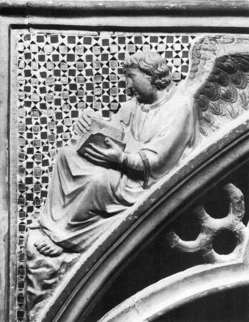At yesterday’s terrific conference on Lectio Divina, the keynote presenter, Trappist Brother Simeon Levia, monk of Saint Joseph’s Abbey, Spencer, MA, gave an incredible talk on doing the work of Lectio Divina at a conference on Lectio sponsored by Mario Paredes and his staff at the American Bible Society. Brother Simeon is an established Catholic thinker.
Category: Lectio Divina
Lectio Divina conference sponsored by American Bible Society
![]() I am exceedingly happy to see the American Bible Society (ABS) responding so quickly to Pope Benedict’s encouragement to delve more deeply into sacred Scripture through the practice of Lectio Divina. The Pope spoke eloquently of Lectio Divina and its need for us to practice in his recent work on Scripture, Verbum Domini.
I am exceedingly happy to see the American Bible Society (ABS) responding so quickly to Pope Benedict’s encouragement to delve more deeply into sacred Scripture through the practice of Lectio Divina. The Pope spoke eloquently of Lectio Divina and its need for us to practice in his recent work on Scripture, Verbum Domini.
Steps of Lectio Divina
 Pope Benedict reviews “… the basic steps of this procedure. It opens with the reading (lectio) of a text, which leads to a desire to understand its true content: what does the biblical text say in itself? Without this, there is always a risk that the text will become a pretext for never moving beyond our own ideas. Next comes meditation (meditatio), which asks: what does the biblical text say to us? Here, each person, individually but also as a member of the community, must let himself or herself be moved and challenged. Following this comes prayer (oratio), which asks the question: what do we say to the Lord in response to his word?
Pope Benedict reviews “… the basic steps of this procedure. It opens with the reading (lectio) of a text, which leads to a desire to understand its true content: what does the biblical text say in itself? Without this, there is always a risk that the text will become a pretext for never moving beyond our own ideas. Next comes meditation (meditatio), which asks: what does the biblical text say to us? Here, each person, individually but also as a member of the community, must let himself or herself be moved and challenged. Following this comes prayer (oratio), which asks the question: what do we say to the Lord in response to his word?
Prayer, as petition, intercession, thanksgiving and praise, is the primary way by which the word transforms us. Finally, lectio divina concludes with contemplation (contemplatio), during which we take up, as a gift from God, his own way of seeing and judging reality, and ask ourselves what conversion of mind, heart and life is the Lord asking of us? In the Letter to the Romans, Saint Paul tells us: “Do not be conformed to this world, but be transformed by the renewal of your mind, that you may prove what is the will of God, what is good and acceptable and perfect” (12:2). Contemplation aims at creating within us a truly wise and discerning vision of reality, as God sees it, and at forming within us “the mind of Christ” (1 Cor 2:16). The word of God appears here as a criterion for discernment: it is “living and active, sharper than any two-edged sword, piercing to the division of soul and spirit, of joints and marrow, and discerning the thoughts and intentions of the heart” (Heb 4:12). We do well also to remember that the process of lectio divina is not concluded until it arrives at action (actio), which moves the believer to make his or her life a gift for others in charity” (Verbum Domini, 87).
Lectio Divina in Verbum Domini
In the Apostolic Exhortation Verbum Domini released today, I immediately started reading the document for what the Pope had to say about lectio divina. You may recall the Pope’s remarks for the 40th anniversary of Dei Verbum in 2005, he said lectio divina will bring about a spiritual springtime in Church. His words were:
“the diligent reading of Sacred Scripture accompanied by prayer brings about that intimate dialogue in which the person reading hears God who is speaking, and in praying, responds to him with trusting openness of heart (cf. Dei Verbum, 25). If it is effectively promoted, this practice will bring to the Church –I am convinced of it– a new spiritual springtime.”
No less than 16 times does His Holiness use the words lectio divina.
Here are some points of interest in Verbum Domini regarding lectio:
46. Listening together to the word of God, engaging in biblical lectio divina, letting ourselves be struck by the inexhaustible freshness of God’s word which never grows old, overcoming our deafness to those words that do not fit our own opinions or prejudices, listening and studying within the communion of the believers of every age: all these things represent a way of coming to unity in faith as a response to hearing the word of God.
48. The interpretation of sacred Scripture would remain incomplete were it not to include listening to those who have truly lived the word of God: namely, the saints. Indeed, “viva lectio est vita bonorum.” The most profound interpretation of Scripture comes precisely from those who let themselves be shaped by the word of God through listening, reading and assiduous meditation. It is certainly not by chance that the great currents of spirituality in the Church’s history originated with an explicit reference to Scripture.
82. Those aspiring to the ministerial priesthood are called to a profound personal relationship with God’s word, particularly in lectio divina, so that this relationship will in turn nurture their vocation: it is in the light and strength of God’s word that one’s specific vocation can be discerned and appreciated, loved and followed, and one’s proper mission carried out, by nourishing the heart with thoughts of God, so that faith, as our response to the word, may become a new criterion for judging and evaluating persons and things, events and issues. Such attention to the prayerful reading of Scripture must not in any way lead to a dichotomy with regard to the exegetical studies which are a part of formation. The Synod recommended that seminarians be concretely helped to see the relationship between biblical studies and scriptural prayer.
Devote yourself to the lectio of the divine Scriptures; apply yourself to this with perseverance. Do your reading with the intent of believing in and pleasing God. If during the lectio you encounter a closed door, knock and it will be opened to you by that guardian of whom Jesus said, ‘The gatekeeper will open it for him.’ By applying yourself in this way to lectio divina, search diligently and with unshakable trust in God for the meaning of the divine Scriptures, which is hidden in great fullness within.
For this reason, the privileged place for the prayerful reading of sacred Scripture is the liturgy, and particularly the Eucharist, in which, as we celebrate the Body and Blood of Christ in the sacrament, the word itself is present and at work in our midst. In some sense the prayerful reading of the Bible, personal and communal, must always be related to the Eucharistic celebration. Just as the adoration of the Eucharist prepares for, accompanies and follows the liturgy of the Eucharist, so too prayerful reading, personal and communal, prepares for, accompanies and deepens what the Church celebrates when she proclaims the word in a liturgical setting. By so closely relating lectio and liturgy, we can better grasp the criteria which should guide this practice in the area of pastoral care and in the spiritual life of the People of God.
87. The documents produced before and during the Synod mentioned a number of methods for a faith-filled and fruitful approach to sacred Scripture. Yet the greatest attention was paid to lectio divina, which is truly “capable of opening up to the faithful the treasures of God’s word, but also of bringing about an encounter with Christ, the living word of God.”
Lectio Divina will bring about a new spiritual springtime in the Church, Benedict recommends
On the occasion of the 40th anniversary Dei Verbum in 2005, Pope Benedict made what I think is a brilliant claim that lectio divina will be instrumental in bringing a new era in the Church. The Pope said:
In this context, I would like in particular way to recall and recommend the ancient tradition of “Lectio divina”: “the diligent reading of Sacred Scripture accompanied by prayer brings about that intimate dialogue in which the person reading hears God who is speaking, and in praying, responds to him with trusting openness of heart” (cf. Dei Verbum, 25). If it is effectively promoted, this practice will bring to the Church — I am convinced of it — a new spiritual springtime. (16 September 2005)
How to do lectio divina
My friends at St Louis Abbey posted this cheat-cheat on doing lectio divina encouraging us to dig deeply into this very necessary form of prayer. All good things are derived from the daily practice of lectio divina. As the monks will tell you, lectio is not only for monks but for the entire Church.
Lectio divina is a way of getting in touch daily in a personal way
with the Father, the Son and the Holy Spirit; it is a way of getting in touch with Jesus Christ our Lord and our brother. It is away of reading centered on God and, if you do it with faith you will be able to hear what he has to say to you here at this moment. It is a way of reading which is slow so that the words are savored in meditation. It moves from the literal meaning to what only the Spirit can make clear to you. It calls for action by your involvement and for passive surrender as it draws you into the heart of God. It is disinterested; the text must be read for its own sake and not for the achievement of having read it.
Lectio is a way of experiencing Jesus Christ. You will encounter him personally in the sacred scriptures because he is there hidden in the pages of your Bible and you ought to believe in his presence with greater assurance than if you could see him with your eyes. He has the same power there as he revealed in the gospels and he cures you of your physical and moral ailments, brings his light to your everyday life and leads you to eternal life.
Your encounter is with the Word who loves you unconditionally and is ever present and real in your life. From all eternity God has had a plan for the whole course of your life, your personal fulfillment, your vocation, your happiness. You will surely stray from the right path and become alienated from your true self through serving other gods, if you do not allow him to reveal himself to you daily through his word. It is in
your Bible that the true story of your life is written. If you don’t at once
understand what you read, then have confidence that the Lord will reveal it to you in his own time, because no word comes form the mouth of the Lord without achieving in you the work he intended. If your thoughts and imagination get in the way of your prayer, then fling them immediately before Christ. Make no attempt to master them by your own strength, but try to turn back to your prayer.
You ought to do lectio every day, even if it is only one single verse of the Bible, because, “It is not on bread alone that man lives but on every word that comes from the mouth of God.” (Matthew 4:4) Your reading of the word of God should be deliberate, moving slowly from verse to verse, from word to word, watching for the context, paying close attention to each passage, looking out for the answers that are there in sacred scripture itself and the echoes they evoke, watching the notes and marginal references and always treasuring silence so as to make space to listen. You should know that the word you hear is directed to you personally and individually. When you read the word of God, it
speaks to you; when you pray, you speak to the word and so turn your prayer into conversation.
Your prayer may be simply staying with the word in silence, or it may be a thanksgiving, or a petition, or praise, or blessing, or contrition, or intercession, or one single word on which you pause and then repeat at will, or it may be a prayer of inspiration. If you are taking part in shared lectio, the way to share what the scripture has said to you is by means of a personal comment spoken in the first person singular and applied to your own life, or else it may be a prayer out loud offered directly to God.
José Manuel Eguiguren Guzman of the Manquehue Movement, Chile; translated by Abbot Patrick Barry, OSB
Daily Rule of Prayer: Mass, adoration, lectio divina…
For the most part, the time for priestly and diaconal ordinations have come and gone. Where I am for the summer, a newly ordained priest is due to arrive in a few days. Having heard plenty of ordination homilies over the years none are as insightful as Benedict XVI’s especially when he proposes a plan to be spiritually fit. Of course, all what is said is not restricted to priests but applicable to the laity as well. All of us reading this post are familiar with all the points made about developing a prayer life and seeing them together constitutes a serious plan. Father Mark draws our attention to one item that is near-and-dear to many of us: lectio divina. I am re-posting a portion of my friend Father Mark’s recent May blog entry because I think it’s helpful.
What is Father Everypriest’s daily Rule of Prayer according to Pope Benedict XVI? Let’s consider the elements of the Rule in the order in which the Holy Father presents them.
1) Daily Holy Mass. Daily. Not 6 days week, not 5, or 4 days a week, but daily. The liturgical cycle in its hourly, daily, weekly, and yearly rhythms is given us precisely to facilitate our “abiding” in Christ hour by hour, day by day, week by week, and year after year. Integral to the liturgical cycle is daily Holy Mass. The Eucharistic Sacrifice sends the divine lifeblood coursing through one’s spiritual organism. Without daily Mass, the priest will succumb to spiritual anemia.
2) The Liturgy of the Hours. The Hours give rhythm and grace to daily life. They are a school of discipline (discipleship), a supernatural system of irrigation channeling grace into every moment of the day, a privileged way of offering thanks in communion with all who, “in heaven, on earth, and under the earth,” confess the Name of Jesus and bend the knee before Him. A priest who loves the Divine Office will enjoy an interior life that is sane, and sound, and wholly ecclesial. Fidelity to the Divine Office refines the Gifts of the Holy Spirit, sharpens one’s discernment, and imparts to everything the priest does a certain Eucharistic and doxological quality.
3) Eucharistic Adoration. Are you surprised? Eucharistic adoration has known a kind of springtime since The Year of the Eucharist (2004-2005) that was also the year of the death of Pope John Paul II and of the election of Pope Benedict XVI. Two Americans known for loving their brother priests and ministering to them tirelessly –Archbishop Fulton J. Sheen and Father Gerald Fitzgerald of the Holy Spirit– insisted on a daily hour before the Blessed Sacrament as a sine qua non of priestly spirituality. The priest who adores the Blessed Sacrament exposes his weaknesses and wounds to the healing radiance of the Eucharistic Face of Jesus. Moreover, he abides before the Eucharistic Face of Jesus as the representative of his people: of the sick, the poor, the bereaved, and of those locked in spiritual combat. The priest who looks to the Eucharistic Face of Jesus, and draws near to His Open Heart in the Sacrament of the Altar, will, just as the psalm says, be radiant, and he will not be put to shame.
4) Lectio Divina. Again — a monastic thing? No, a Catholic thing. The quality of a priest’s preaching is directly proportionate to his commitment to lectio divina. Neglect of lectio divina leads to mediocre preaching. Opening the Scriptures is like opening the tabernacle: therein the priest finds the “hidden manna” his soul craves. The four steps of lectio divina can be accommodated to any length of time: 1) lectio, i.e. the Word heard; 2) meditatio, i.e. the Word repeated; 3) oratio, i.e. the Word prayed;
4) Contemplatio; i.e. the indwelling Word. Lectio divina cannot be occasional;
it is not a random pursuit. Learn to say, “I am not available.” Get over feeling guilty about taking time for God!
5) Holy Rosary. Yes, the daily Rosary. It’s a spiritual lifeline that has saved many a priest from spiritual shipwreck. The brilliant and holy exegete and founder of the École biblique in Jerusalem, Father Marie-Joseph Lagrange, was observed praying fifteen mysteries of the Rosary each day, and asked, “Why, Father, do you, a great exegete, need to pray the Rosary?” “Because, ” he answered, “it decapitates
pride.” I would add that not only does the Rosary decapitate pride; it decapitates each of the seven capital sins: pride, greed, lust, anger, gluttony, envy, and sloth. With the passing of the years I have come to appreciate the profound wisdom of an old Dominican priest to whom I used to make my confession years ago. Invariably, after confessing my miseries, Father would ask, “Do you say the Rosary, son?” And invariably I would reply, “Yes, Father.” And then he would say, “Aye, then you’ll be alright.” A priest who prays the Rosary daily will be alright and, almost imperceptibly, will grow in purity and humility.
6) Meditation. Meditation can mean many things, even within our Catholic tradition. It is integral to the prayerful celebration of Holy Mass and the Hours. “it nourishes Eucharistic adoration. It is the second “moment” of lectio divina. It is the soul of the Rosary. In my own experience, meditation is related to “remembering the things the Lord has done.” Saint Gertrude the Great, a model of the mystical life grounded in the liturgy, used to say, “A grace remembered is a grace renewed.” Understood in this sense, meditation, by recalling the mercies of the Lord in the past, infuses the present with hope, and allows the priest to go forward with a holy boldness.
Is it necessary to set a period of time apart for meditation as such? That depends on whom you ask. The Carmelite, Jesuit and Sulpician traditions would hold fast to some form of meditation as a daily exercise. The monastic tradition has, on the whole, taken a more supple approach to meditation. It is a daily practice, but one diffused in every form of prayer, including the liturgy itself. One learns to pace one’s prayer, to pause, to breathe, to linger over a phrase, a word, or an image. Whether one espouses the Ignatian way or the monastic approach, meditation is an integral to every priest’s daily Rule of Prayer.
The encounter with Christ?
Basilian Father Thomas Rosica, in his weekly article on the forthcoming Sunday Scriptures, “To What Lengths Are We Willing to Go to Encounter Jesus?” asks:
Do we share the paralytic man’s faith in today’s Gospel? Do we have the chutzpah, creativity, perseverance and persistence of his friends to bring someone to Christ? To what lengths are we willing to go to encounter Jesus? How much are we willing to sacrifice so that our friends, too, might hear his saving word and experience the Lord’s healing touch and presence?
Find the article here.
AND the answer is? What does your time doing Lectio Divina reveal to you?
Lectio Divina
This article by Jesuit Father John Belmonte on lectio divina is helpful for coming to know the Lord. Lectio is a place of encounter with the Lord and it is in lectio we come to know and love Him in whom and by whom we are saved.
Talk show host Jay Leno has a very funny segment on his “Tonight Show” where he interviews the “man on the street,” testing people’s knowledge in a given subject matter. Rare is the person who does well. On one occasion, he asked questions about a topic that keenly interests me: the Bible. While the survey was hardly scientific, the questions were very basic. No historical-critical method here. “Name one of the Ten Commandments,” Jay asked. “Freedom of speech,” a man unhesitatingly responded. “Name the four Gospels,” Jay asked. With a befuddled look, a woman was unable to answer. “Name the four Beatles,” Jay asked. Without any hesitation and a relieved smile, the woman responded, “John, Paul, George, and Ringo.” My personal favorite was the man whom he asked, “In the Old Testament, who was swallowed by the whale?” He looked directly into the camera and, as serious as death, said, “Pinocchio.”
As someone who has taught Scripture to high school students, these answers did not surprise me. Religious educators and biblical scholars regularly decry a growing lack of familiarity with Scripture. Catholic ignorance of the Bible is proverbial. A study of 508 teenagers by the Princeton Religion Research Center confirmed that Catholic young people are much less familiar with Scripture than their Protestant counterparts. Even more distressing is the finding that thirty percent said that they never even opened the Bible. If Saint Jerome’s axiom, “Ignorance of the Scriptures is ignorance of Christ,” is true, then those of us who are full members of the Catholic Christian community have a serious situation on our hands. Isn’t it incumbent upon us to pass on the tradition, to introduce others to the living God, to dispel ignorance of the Word of God? If not us, then who?
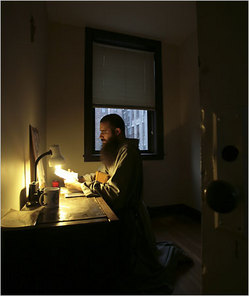 Even amid the decline in elementary biblical knowledge, help is on the way. Vatican II did much to help revive interest in Scripture, and one method that may help bridge the gap Mr. Leno so cleverly pointed out is the ancient monastic method of reading the Bible called lectio divina. The Latin expression lectio divina does not translate into English with great accuracy. Literally, it means “holy reading within the monastic tradition, and in Saint Benedict’s rule in particular, its meaning is obvious. Lectio divina is an attentive and in-depth reading of the sacred Scriptures intended not simply to satisfy one’s curiosity but to nourish one’s faith. Benedict’s monks were to nourish themselves with the divine food of Scripture in order to have sufficient resources for the journey of faith. In the Rule of Saint Benedict, the monk is exhorted to listen carefully and willingly to holy readings, the lectiones sanctae. The reading is holy because its object is the word of God. Scripture is approached not for scientific or technical reasons but in order to deepen one’s personal commitment to God and God’s Son.
Even amid the decline in elementary biblical knowledge, help is on the way. Vatican II did much to help revive interest in Scripture, and one method that may help bridge the gap Mr. Leno so cleverly pointed out is the ancient monastic method of reading the Bible called lectio divina. The Latin expression lectio divina does not translate into English with great accuracy. Literally, it means “holy reading within the monastic tradition, and in Saint Benedict’s rule in particular, its meaning is obvious. Lectio divina is an attentive and in-depth reading of the sacred Scriptures intended not simply to satisfy one’s curiosity but to nourish one’s faith. Benedict’s monks were to nourish themselves with the divine food of Scripture in order to have sufficient resources for the journey of faith. In the Rule of Saint Benedict, the monk is exhorted to listen carefully and willingly to holy readings, the lectiones sanctae. The reading is holy because its object is the word of God. Scripture is approached not for scientific or technical reasons but in order to deepen one’s personal commitment to God and God’s Son.
Lectio Divina from the Monastery to the Marketplace
All quarters of the church, from official pronouncements to informal movements, have in recent times repeatedly affirmed the need for and effectiveness of lectio divina. There are many ways in which one can encounter God through the biblical word. Yet, the rich history, significant connection to tradition, genuine spirituality, and pastoral applicability of lectio divina make it a particularly attractive method.
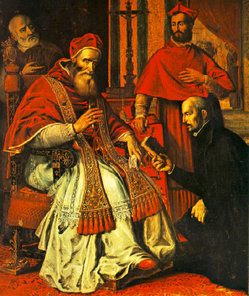 Lectio divina is one instrument of grace by which we encounter Christ in the Scriptures. When practiced every day, lectio divina fosters the kind of contact with God’s word that, over the course of a lifetime, promises a life of prayer lived out in faithful love. To suggest that a specific method for lectio divina might be necessary carries with it a risk. In our practice of this method, we might be tempted to follow rigidly the proposals offered as rules and not as suggestions. To do so would be a mistake. What lectio divina demands in the first place is an openness to the Spirit, which any master of the spiritual life would see as a prerequisite to prayer. Ignatius of Loyola’s instruction in his Spiritual Exercises to those who intend to pray is a good example. He suggests that believers must always pray “with great spirit and generosity toward their Creator and Lord.” Balance and flexibility are very important as one begins to practice lectio divina. We should always avoid rigidity, excessive formalism, or forcing things. My intention is not that the suggested schema that follows be realized as a fixed program; lectio divina is a way to encounter God, and we should always feel free to utilize it according to our own rhythms, gifts, and desires.
Lectio divina is one instrument of grace by which we encounter Christ in the Scriptures. When practiced every day, lectio divina fosters the kind of contact with God’s word that, over the course of a lifetime, promises a life of prayer lived out in faithful love. To suggest that a specific method for lectio divina might be necessary carries with it a risk. In our practice of this method, we might be tempted to follow rigidly the proposals offered as rules and not as suggestions. To do so would be a mistake. What lectio divina demands in the first place is an openness to the Spirit, which any master of the spiritual life would see as a prerequisite to prayer. Ignatius of Loyola’s instruction in his Spiritual Exercises to those who intend to pray is a good example. He suggests that believers must always pray “with great spirit and generosity toward their Creator and Lord.” Balance and flexibility are very important as one begins to practice lectio divina. We should always avoid rigidity, excessive formalism, or forcing things. My intention is not that the suggested schema that follows be realized as a fixed program; lectio divina is a way to encounter God, and we should always feel free to utilize it according to our own rhythms, gifts, and desires.
Having pointed out the importance of some prerequisites to lectio divina, such as balance,
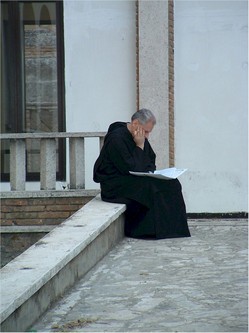 openness, and flexibility, a word is in order about the structure or steps that this ancient practice usually takes. Much has been written about these steps, but the most exhaustive and perhaps best-known example comes from Guigo II (1115-1198), the Cistercian prior at Chartres from 1173 to 1180. In his “Letter on the Contemplative Life,” also known as Scala Claustralium, Guigo gives the classic four-part expression to the lectio divina: lectio, meditatio, oratio, and contemplatio. Since Guigo’s text has become a nearly obligatory point of reference for someone considering lectio divina, it seems appropriate to reproduce here a brief summary citation from the letter:
openness, and flexibility, a word is in order about the structure or steps that this ancient practice usually takes. Much has been written about these steps, but the most exhaustive and perhaps best-known example comes from Guigo II (1115-1198), the Cistercian prior at Chartres from 1173 to 1180. In his “Letter on the Contemplative Life,” also known as Scala Claustralium, Guigo gives the classic four-part expression to the lectio divina: lectio, meditatio, oratio, and contemplatio. Since Guigo’s text has become a nearly obligatory point of reference for someone considering lectio divina, it seems appropriate to reproduce here a brief summary citation from the letter:
One day during manual labor, as I was beginning to reflect on the spiritual exercise of man, suddenly four spiritual steps appeared to my mind: reading, meditation, prayer, and contemplation. This is the ladder of the monks by which they are elevated from the earth to heaven and even though it may be formed by only a few steps, nevertheless it appears in immense and incredible greatness. The lower part rests on the earth; however, the higher part penetrates the clouds and scrutinizes the secrets of the heavens.
Now the reading consists in the attentive observation of the Scriptures with one’s spirit applied. The meditation is the studious action of the mind, which seeks the discovery of hidden truth by means of one’s own intelligence. The prayer consists in a religious application of the heart of God in order to dispel evil and obtain favors. The contemplation is an elevation into God, from the mind attracted beyond itself, savoring the joys of eternal sweetness….
Reading seeks the sweetness of the blessed life, while meditation finds it. Prayer asks for it and contemplation tastes it. Reading, in a certain way, brings solid food to the mouth, meditation chews and breaks it up, prayer obtains its seasoning, contemplation is the same sweetness which refreshes and brings joy.
Guigo sets down a four-part method, but for our purposes we will reduce that structure to three: lectio, meditatio, and oratio. The reason for collapsing the final two steps into one is simple. Prayer is at the core of the way the two final steps are conceived. By collapsing them into a third phase, we respect the progression that naturally develops from the first two steps. However, we leave open the possibility of expanding on the process of prayer by adding three more steps: discretio, deliberatio, and actio. Some critics object to any tinkering with the traditional structure of lectio divina. Even so, a brief look at the historical development of the method over the centuries shows that one can understand Guigo’s four steps as an expression of the monastic world of his time. Our minor change should be viewed in the same light.
The Practice of Lectio Divina
The first thing necessary to practice lectio divina should be obvious: time. As with anything worth doing or any relationship worth maintaining, the practice of lectio divina must be worth spending time doing. While we should avoid the kind of rigidity described above, the spiritual life does demand a certain amount of healthy discipline. Whether we want to fix a regular time, a certain period, or the most effective time, regularity is important. Our time is a precious thing, and offering it to God is a very simple and concrete first step toward our meeting God in prayer.
 Equally obvious but also quite necessary to consider is which text to use for lectio divina. Our emphasis in lectio divina remains squarely with the biblical text. It is possible to substitute other texts for biblical texts; however, we should not lightly forfeit the surpassing value of reading, meditating, and praying with what the Fathers called the sacra pagina. Jerome himself reminds us that “the text presents itself simply and easily in words, but in the greatness of its meaning, its depth is unfathomable.”
Equally obvious but also quite necessary to consider is which text to use for lectio divina. Our emphasis in lectio divina remains squarely with the biblical text. It is possible to substitute other texts for biblical texts; however, we should not lightly forfeit the surpassing value of reading, meditating, and praying with what the Fathers called the sacra pagina. Jerome himself reminds us that “the text presents itself simply and easily in words, but in the greatness of its meaning, its depth is unfathomable.”
Related to our emphasis on the biblical text itself is the presupposition that lectio divina is a continuous reading of the whole Bible. In our practice of lectio divina, we should avoid the temptation to select texts well suited to topics chosen in advance. By attending to the whole of Scripture, as the liturgy does in the lectionary, we preserve the context of biblical revelation, both the Old and New Testament. We must avoid the risk of allowing the lectio to “overflow the riverbanks of the tradition and the church,” as Cardinal Martini has written. Practicing lectio divina within the context of the whole of biblical revelation emphasizes the unity of Scripture and our belief in the Bible’s inspiration by God. Moreover, emphasis on the unity of Scripture allows us to avoid the temptation of placing Scripture at the service of ideology or subjectivism.
 Time set aside for God should take on a dimension different from the rest of one’s day. To help mark that moment, most spiritual masters suggest that the person who sets out to pray begin by making some kind of epiclesis, which is an invocation or “calling down” of the Holy Spirit to consecrate. In the Eucharist, we call down the Spirit upon the bread and wine to transform them into the body and blood of Christ. As we begin lectio divina, we should remind ourselves that it is through the work of God in the Spirit that the written word is transformed in our lives into the living word.
Time set aside for God should take on a dimension different from the rest of one’s day. To help mark that moment, most spiritual masters suggest that the person who sets out to pray begin by making some kind of epiclesis, which is an invocation or “calling down” of the Holy Spirit to consecrate. In the Eucharist, we call down the Spirit upon the bread and wine to transform them into the body and blood of Christ. As we begin lectio divina, we should remind ourselves that it is through the work of God in the Spirit that the written word is transformed in our lives into the living word.
The Four Steps of Lectio Divina: Lectio, Meditatio, Oratio, Actio
Having set aside the time, “selected” the text, and invoked the Spirit, we are ready to begin the first formal step of lectio divina, called the lectio. This is the moment in which we read and reread a passage from the Old or New Testament, alert to its most important elements. The operative question is, What does the text say? Patient attentiveness to what the text has to say characterizes our stance before it. We should read the text for itself, not to get something out of it, like a homily, a conference, or a catechism lesson. The word of God should be allowed to emerge from the written word.
In lectio, each person’s experiences and talents before the text come into play. The more experience or education one has, the more one will potentially bring to the text. Knowledge of biblical languages or an understanding of theology can also enrich one’s reading. Consultation of available biblical commentaries or dictionaries can be especially helpful as we attempt to expand our understanding about what the text is saying. Paying attention to grammar, the usage of words, and the relationships of verbs to nouns or of subjects to objects can make the text begin to take on new and unexpected significance.
 The second step, called the meditatio, is equally important. We leave behind the specifics of the text and focus instead on what is behind it, on the “interior intelligence” of the text, as Guigo puts it. The meditatio is a reflection on the values which one finds behind the text. Here, one must consider the values behind the actions, the words, the things, and the feelings which one finds in a particular scriptural passage. Anyone who honestly seeks God and one’s authentic self in prayer will hear the echoes of joy, fear, hope, and desire coming from the sacred page. The operant question for this stage doesn’t stop at what the text says, but asks, What does the text say to me? We seek to make emerge from history and context the specific message of the text. The shift from external forms to internal content makes this stage an important one.
The second step, called the meditatio, is equally important. We leave behind the specifics of the text and focus instead on what is behind it, on the “interior intelligence” of the text, as Guigo puts it. The meditatio is a reflection on the values which one finds behind the text. Here, one must consider the values behind the actions, the words, the things, and the feelings which one finds in a particular scriptural passage. Anyone who honestly seeks God and one’s authentic self in prayer will hear the echoes of joy, fear, hope, and desire coming from the sacred page. The operant question for this stage doesn’t stop at what the text says, but asks, What does the text say to me? We seek to make emerge from history and context the specific message of the text. The shift from external forms to internal content makes this stage an important one.
The meditatio is an activity that engages our intellect. As we pass from the second to the third stage of lectio divina, we move more into the realm of religious emotions. Remaining on an intellectual level can be safe and comfortable, but the goal of prayer is not knowledge about God, but God himself. In the oratio, our imagination, will, and desires are engaged as we seek union with God. Oratio in its most fundamental sense is dialogue with God. Gregory the Great called it “the spontaneous meeting of the heart of God with the heart of God’s beloved creature through the word of God.”
When we progress from meditatio to oratio, an immediate experience of infused mysticism is hardly to be expected. Mystical union with God is not necessarily an ordinary part of Christian life. Nevertheless, the passage from meditatio to oratio is the vital and decisive moment of Christian experience. The more deeply we enter the oratio, the more we move beyond the text, beyond words and thoughts. The lectio is useful and the meditatio is important since they lead us to the oratio, which is life in its fullest sense, the life of Christ that he lives in the one who contemplates him. Oratio is the passage from the values behind the text to adoration of the person of Jesus Christ, the one who brings together and reveals every value. Unlike the lectio and meditatio, there is no operant question in the oratio. At its core, oratio is the silent adoration of the creature before the Creator, a rare and miraculous gift.
When the person who practices lectio divina reaches the level of oratio, it would seem that that moment would be conclusive. However, the dynamism of prayer that began during the epiclesis before the lectio is not interrupted here. To the contrary, it naturally continues and the oratio, as we are proposing it here following Cardinal Martini’s insight, possesses its own steps, called discretio, deliberatio, and actio. These three steps represent the way lectio divina is lived out in daily life. Given the growing dissociation of the faith from daily life, these three successive moments take on great significance.
Since the meditatio intends to put one in contact with the values of Christ, to encourage our identification with those things that are important to Christ, we naturally come to moments of decision. The discretio is the capacity that the Christian acquires through grace to make the same choices as Christ. Cardinal Martini describes discretion like this: “It is the discernment of that which, in a determined historical moment, is best for oneself, for others, and for the church.”
The second moment of the oratio is called the deliberatio. It is an interior act by which one decides in favor of the values of the gospel. One chooses to associate oneself with Christ and everything that association represents–in a word, discipleship. If the discretio is described as the capacity of a person to choose, then the deliberatio is the choice itself.
The final moment is called actio. In this final step, the choice we make in the deliberatio is given form and substance. Prayer becomes something more than simply setting aside time for God or an attempt to better ourselves. Our lives begin to take shape from the choices we have made as a result of prayer. The actio is the integration of a kind of apostolic consciousness that informs our choices so that we have made and lived our choices from our encounter with the living God.
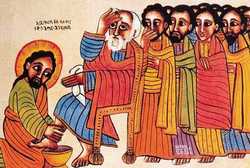 Some critics would leave these last steps, particularly the actio, out of any proposed lectio divina. The addition of an extra step suggests perhaps overzealousness or even the influence of an “ideology of efficacy” regarding one’s prayer. Too often we feel we need to make prayer into something. However, in the face of a modern world in which the outward signs of the mystery of God are ever more difficult to recognize, where a daily experience of gospel or even transcendent values becomes harder to find, and where choices besiege one’s conscience and stifle rather than uplift the Spirit, this criticism is unconvincing. If anything, the connection between prayer and our life choices should become more explicit, not less. The faith, hope, and love made manifest in the choices our lives become must be nourished by contact with the word of God.
Some critics would leave these last steps, particularly the actio, out of any proposed lectio divina. The addition of an extra step suggests perhaps overzealousness or even the influence of an “ideology of efficacy” regarding one’s prayer. Too often we feel we need to make prayer into something. However, in the face of a modern world in which the outward signs of the mystery of God are ever more difficult to recognize, where a daily experience of gospel or even transcendent values becomes harder to find, and where choices besiege one’s conscience and stifle rather than uplift the Spirit, this criticism is unconvincing. If anything, the connection between prayer and our life choices should become more explicit, not less. The faith, hope, and love made manifest in the choices our lives become must be nourished by contact with the word of God.
Conclusion
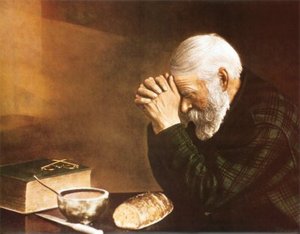 Lectio divina is one graced instrument to bridge the gap that exists between our hearts and God’s. As the faith risks being further dissociated from daily life, the simplicity and potential of a method like lectio divina take on greater significance. Firmly rooted in the church’s tradition, it presumes careful attention to what biblical specialists are thinking and teaching. Rigorous study is complemented by disciplined meditation and prayerful contemplation of the word of God. Far from being an objective or rigid technique whereby one produces religious experience, lectio divina represents daily contact with God’s word that occurs within a lifetime’s engagement with the Living God. The principal aim of such engagement is to foster living prayer in faithful love. Lectio divina unfolds more than it proceeds; progresses and develops more than it advances.
Lectio divina is one graced instrument to bridge the gap that exists between our hearts and God’s. As the faith risks being further dissociated from daily life, the simplicity and potential of a method like lectio divina take on greater significance. Firmly rooted in the church’s tradition, it presumes careful attention to what biblical specialists are thinking and teaching. Rigorous study is complemented by disciplined meditation and prayerful contemplation of the word of God. Far from being an objective or rigid technique whereby one produces religious experience, lectio divina represents daily contact with God’s word that occurs within a lifetime’s engagement with the Living God. The principal aim of such engagement is to foster living prayer in faithful love. Lectio divina unfolds more than it proceeds; progresses and develops more than it advances.
Dedicated practice engages the whole person–the intellect as well as the imagination, the will as well as the affect. It promises contact with God that is the normal fulfillment of prayer. Lectio divina is open to every person and not the exclusive property of a select few. Those who practice lectio divina reaffirm the belief that the proper place for the word of God is in the hands of the faithful.
Wouldn’t Geppetto have been pleased if, instead of his firm response, “Pinocchio,” that young man had looked into Jay Leno’s TV camera and answered with conviction, “Jonah”?
Reprinted from Chicago Studies 39 (2000): 211-19.
Lectio Divina
Bishop Santiago Jaime Silva Retamales, Auxiliary Bishop of Valparaíso, (Chile) presented this Explanatory Exposition of Lectio Divina at the Synod of Bishops today:
This explanation is not as much to understand, but to make Lectio Divina more systematic, to live it personally and help the community to live it.
The first aspect to be considered in Lectio Divina is a spirituality understood as the dynamism of holiness:
– God moves towards humanity and invites it to live in communion with Him. The revelation, understood in categories of dialogue and encounter, requires a reading of the Word of God as the place for communion. The Holy Scripture and Lectio Divina require a theological and a personal approach.
– God offers Himself completely through His Son Jesus Christ. Jesus the Son of Man, is the vocation of man, inasmuch as a human being. The encounter with Jesus “leads us to ourselves”: personality, history, motivations, intentions, and “recreates” us, a new creature in Jesus, the new Adam.
The second aspect, the identity and the function of the Holy Scripture in the life of the Church.
The Dogmatic Constitution Dei Verbum shows that the Holy Scripture is:
– the written Word of God, that must be interpreted;
– is inspired by the Holy Spirit, is an actual and efficacious Word, which must be realized;
– is entrusted to the Church for the salvation of all: it is the Word that calls and that one must proclaim
How can we nourish ourselves with the richness of the Holy Scripture to follow the Lord and grow on the path to holiness?
The practice of Lectio Divina is the prayerful reading of Holy Scripture, individual or in a group, to “learn the heart of God through the words of God” (Saint Gregory the Great). The Holy Scripture is the written Word of God. In reading (re-interpreting), we ask ourselves: What does the Biblical text say? We must understand the Word to discover what God teaches us through the inspired author.
The Holy Spirit is inspired by the Holy Spirit. In meditation (personalizing), we ask ourselves: “What does the Lord say in His Word?” We must practice the Word to call upon life, learn its meaning, better our mission and reinforce hope. In prayer we ask: What do we say to the Lord, motivated by His Word? We must pray the Word for dialogue with God and celebrate our faith in the family or in the community.
The Holy Scripture is entrusted to the Church for salvation. In contemplation-practice (proclaiming), we ask ourselves: “What conversion is asked for by the contemplation of the Lord?” We must contemplate the Word (Jesus) to live according to the criteria of the Father (conversion). Practical example: (John 1:35-42), encounter with the first disciples of Jesus.
Prepare the external setting (ambo, Bible…) and the spiritual one (“be seated”, “clear heart”…).
· Invoke the gift of the Holy Spirit
· Look for the Biblical passage
· Reading: proclaim the text, making the silences important as well. Read the passage personally and mark with a question mark what you do not understand, or underline it when it seems to be the main message of the reading.
In a group, discover the main message following the signs. Continue reading the passage, putting an exclamation point, for meditation, when the passage calls for intentions and actions; with an asterisk, for prayer when the passage helps us pray.
Reading – Meditation – Prayer – Contemplation




